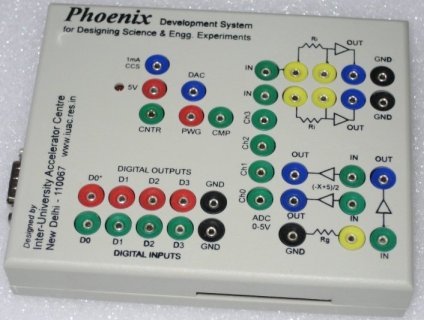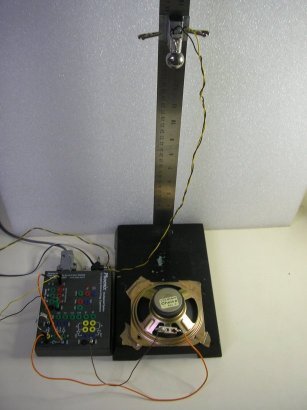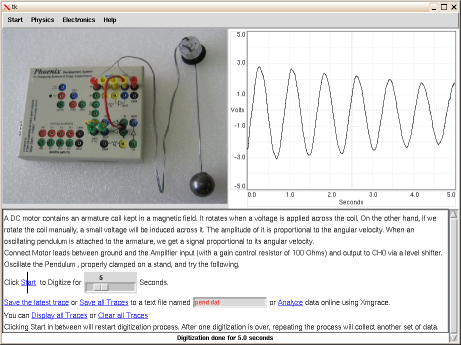Recent Developments in the Phoenix Project
By Kishore A
Introduction
When you conduct experiments in modern Physics, the equipment involved is often complicated, and difficult to control manually. Also, precise measurement of time, and fast and continuous measurement of physical quantities are often required. Consequently, such experiments are automated and computer-interfaced. This means that the scientist carries out the experiment by controlling the equipment using a computer.
Carrying out an experiment consists of different steps. The first step is to activate the equipment, that is, to start the physical phenomenon which is to be studied. For example, in a simple pendulum experiment, this step would be to set the pendulum in motion. Once the physical system is active, we record the observations. This is the second step - data acquisition. The final step is the analysis of the data obtained. Computers are unique in that they can be used for all these three steps, with the appropriate peripheral equipment.
What is Phoenix?
When a student who has completed her post-graduate studies in Physics starts doing research, she inevitably has to carry out computer-interfaced experiments. But we do not get such exposure in our education system, even at the post-graduate level. As a result, it is likely that the student would find herself in highly unfamiliar territory. Of course, the research facility would provide a friendly interface and adequate help to the student to complete her experiment successfully, but chances are that the student might not have developed a feel for the whole procedure. This affects the quality of research.
So what is the way out? The obvious solution is to introduce computer- interfaced experiments right at the undergraduate or even high school level. One of the main obstacles is the cost involved. Though computers have become inexpensive, commercially available data acquisition hardware is too expensive to be affordable for college labs, where teaching/learning and not research is the main objective. Thus the idea of building a low-cost data acquisition hardware, and subsequently "Physics with Home-made Equipment and Innovative Experiments" (Phoenix), evolved. Phoenix is a big step in the right direction. It is easily affordable for colleges and can be interfaced with personal computers via 100% free and open source software.
Read the article Experimental Physics with Phoenix and Python by Pramode.C.E, published in 2005, to get an idea about the project. Here I will talk about some of the recent developments.
The Interface
The first version of Phoenix was completed around September 2004. It communicated with the computer through the parallel port interface, and depended entirely on the computer CPU for control. Time measurements were done using the CPU clock itself, using real time operating system features. The device driver took care of all the control and measurements. It was first implemented using DOS, and later using real time Linux. As it later became completely based on free and open source software (FOSS), it attracted interest from the FOSS community, most notably from Pramode C E , who continues to be an active developer/promoter of Phoenix. As a result, demonstrations of Phoenix have since been held at some of the prominent FOSS events like FOSS.IN, FOSSMeet@NITC, etc.
But the parallel port version was never going to be viable in the long run. For one thing, it was bulky. More importantly, for using it on a computer, you had to compile the device driver with the kernel. This would have been too difficult a task for the end user. As a result, it was not very portable, in the sense that you could not just plug Phoenix in and start using it. Some amount of expertise in programing was required for installing the Phoenix driver. It is still a valuable tool for students for learning how to write device drivers, though.

This led to a complete redesign of Phoenix in early 2006. The new design was based on the Atmel ATMega16 microcontroller , which shifted the control tasks from the real time kernel, to the firmware (written in C and compiled using the AVR-GCC cross compiler) running on the microcontroller. This made things a lot simpler. Now once you burned the firmware into the microcontroller flash memory, all you needed was a code library to communicate with it from the PC (through the RS232 serial port interface). No more complicated device drivers! Also, this made the hardware schematic simpler and easier to debug. The new version of Phoenix was named the Phoenix-Mini, or Phoenix-M for short. It was also much more compact (13cm x 10.5cm x 2.5 cm) and cheaper (it costs only around Rs.1500 [Editorial note: about US$35 at time of publication - pretty darn amazing for a project of this scope! -- Ben]) than its predecessor.
Using Phoenix
One of the objectives of Phoenix is to carry out computer-interfaced scientific experiments "without getting into the details of electronics or computer programing". For this purpose, Phoenix has a comprehensive software library in C and Python. The simplest way to communicate with Phoenix would be to use Python. The following code segment can be used to read the Digital Inputs of Phoenix.
>>>import phm #Phoenix library >>>p = phm.phm() #Initialize a Phoenix "object" >>>p.read_inputs() #Read the digital inputs (all internally pulled up to HIGH when open) 15 >>>
Consider an experiment for calculating the value of acceleration due to gravity by measuring the time of freefall of an object. A small metal ball is held by a solenoid, which is energized by one of the Digital Outputs (say D0), at a known height. A speaker is kept on the base, to pick the vibrations when the ball hits the surface. Since these signals would be weak, they are fed to one of the Digital Inputs (say D3), through an amplifier. You need to measure the time taken by the ball to hit the ground after it is detached from the coil. This can be done as follows:

>>>import phm >>>p = phm.phm() >>>p.write_outputs(1) #Set D0 HIGH to Energize the coil >>>p.clr2rtime(0,3) #Release the ball and measure time of fall (returns time in microseconds) 317345 >>>
The class Phoenix contains a variety of functions (methods) for experiment control and data acquisition. They can be broadly classified into simple input/output, block read, time measurement, and other functions - details of which are given on http://iuac.res.in/~elab/phoenix/software/doc/phlib.html. You can also refer to the Phoenix manual for detailed documentation.
Graphical User Interface
Phoenix has a crisp Graphical User Interface. The GUI programs are very useful for beginners to get started, though of course they can never be a substitute for actual programing. There are mainly two GUI programs - Experiments and CROPlus. Experiments is a collection of all the experiments under one roof. It has a friendly interface - with a photograph of the equipment, a short description of the experiment, and buttons for necessary control and data analysis. CROPlus is a software implementation of a low-frequency storage oscilloscope. It also provides the user with a visual front end to many I/O and time measurement functions. Both these programs have been developed using the TkInter toolkit.


Workshops
Many workshops have been conducted to acquaint physics teachers with computer-interfaced experiments using Phoenix. The first Phoenix workshop was held on 11 November 2004 at the University of Calicut, Kerala. The first workshop hosted by IUAC was conducted from the 3rd to the 14th of October 2005. Many such workshops have been held since. Teachers from all parts of the country have taken part in these programs, and more such workshops will be conducted in the future. You can find a complete list of the Phoenix workshops conducted so far, as well as announcements regarding future workshops at http://iuac.res.in/~elab/phoenix/workshops/index.html .
Ready for the Market!
Phoenix-M was ready by the end of May 2006, and started being produced commercially by three different vendors in different parts of India. You can find information about these vendors at http://iuac.res.in/~elab/phoenix/vendor.html . Since the cost of research and development is funded by the IUAC and the schematics are made freely available, the vendors are able to provide the hardware at a low price, based on the cost of raw material and the labour involved.
Phoenix Live CD
By this time, workshops were being held in different parts of the country, and the need for a portable suite of the Phoenix software libraries arose. This resulted in the development of the Phoenix Live CD, which is a complete customized GNU/Linux operating system (based on the Slax live CD) which you can boot from the CD without needing to install anything to the hard disk. It contains, apart from all the software needed to use Phoenix, a collection of free and open source scientific/educational software tools. You can download the Phoenix live CD from http://iuac.res.in/~elab/livecd_images/index.html . A new version based on Debian GNU/Linux is also being developed.
Recent Developments
Laptop computers have become popular, and many of them do not provide the RS232 interface. So, a new USB version of Phoenix-M was developed in late 2007. It communicates with the computer using a USB to RS232 converter implemented by firmware running on a dedicated on-board controller. Apart from this, the Phoenix Microcontroller Development Kit (PMDK) has also been developed to provide a low cost, easy to use microcontroller development system, mainly for engineering students and electronics enthusiasts. Several add-on boards have also been designed for use with PMDK. This modular structure is useful for application in the projects of engineering students.
Future Direction and Challenges
The Phoenix project has matured since its beginning in 2004. We now have a reliable, cost-effective product which is ready for mass deployment. Its basic design is well documented and a set of experiments have been developed. Some academic institutions have already started using Phoenix. For example, the West Bengal University of Technology (WBUT) has included it in their refresher course for physics teachers. The Department of Education, Kerala, has initiated a project to use Phoenix as a tool for IT-enabled education at the high school level.
Many challenges still lie ahead before Phoenix can become a regular part of the curriculum. First of all, many more experiments need to be designed and developed in such a form that they can fit into a 2-hour lab slot. With an objective to involve the academic community in developing new experiments, the Inter University Accelerator Centre has announced an "Experiment Design Contest", with an attractive prize of Rs.10,000 for the best experiment. The last day for submission of ideas is 31 August 2008. The details regarding the contest can be found at http://iuac.res.in/~elab/phoenix/prize.html .
Computer interfacing of scientific experiments is an entirely new concept to most of the physics teachers and students in India. This hurdle can be overcome only through a series of Phoenix workshops. For its effect to be far-reaching, we need to build a community of enthusiasts from different parts of the country who can help in conducting workshops. Only with a strong community and user base, can we be assured that Phoenix will succeed in realizing its potential to revolutionize science education in India.
Acknowledgements
I compiled this article mainly from the interactions I was fortunate to have had, with Ajith Kumar B.P., developer of Phoenix, while working with him on Phoenix at the Inter University Accelerator Centre, Delhi during my summer holidays. I'm also indebted to my cousin and mentor, Pramode C.E., for introducing me to Phoenix.
Suggested Reading
- A Report on Phoenix, by Ajith Kumar B.P.
- Experimental Physics with Phoenix and Python, by Pramode C.E.
Talkback: Discuss this article with The Answer Gang
![[BIO]](../gx/authors/kishore.jpg)
I am currently doing my BTech in Electronics and Communication Engineering at the National Institute of Technology Calicut. I started using GNU/Linux in 2005 after being fed up with viruses, but haven't looked back since! I have been highly influenced by the writings of RMS, and the Free Software Philosophy in general.

